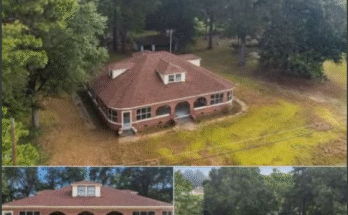The Curse of Blackthornne Valley: Nine Generations of the Thorn Bloodline and Their Haunting Transformation
In the mist-shrouded heart of the English countryside lies Blackthornne Valley, a place where the soil itself seems to breathe with memory. Locals still whisper of a family whose name became synonymous with both brilliance and darkness — the Thorns of Blackthornne Hall. For nine generations, their legacy has been one of wealth, mystery, and an inexplicable curse said to have twisted their fate across centuries. What began as a story of triumph soon descended into a haunting transformation — one that blurred the lines between the living and the lost.
The Beginning: A Pact Sealed in Shadow
The story began in 1621, when Lord Alaric Thorn, a nobleman and scholar, purchased the valley’s sprawling estate. Obsessed with the study of ancient lore, Alaric delved into the forgotten pagan rituals that predated Christianity in the region. He believed the land held power — a pulse that could grant immortality to those who understood its rhythm.
According to a leather-bound diary found centuries later, Alaric performed a midnight ritual under the blackthorn trees that gave the valley its name. The ritual promised prosperity and protection for his bloodline — but required a “living covenant.” Villagers claimed they heard cries echoing through the woods that night, though none dared investigate.
Soon after, Alaric’s fortune grew. The soil around the estate became fertile, producing crops that thrived even during famine. But his wife, Lady Elspeth, was found wandering the moors days later, whispering that “the roots are listening.” Her mind never recovered.
Thus began the curse — subtle at first, then undeniable.
The Second Generation: The Eyes of the Night
Alaric’s son, Sebastian Thorn, inherited not only his father’s estate but also his obsessions. He was a gifted astronomer and engineer, yet plagued by nightmares of roots winding through his veins. Servants reported seeing him pacing the halls by candlelight, muttering in Latin, his eyes unnaturally reflective, like an animal’s in the dark.
By 1690, rumors spread that Sebastian had been visited by “the Lady in the Thorns,” a ghostly woman said to appear during the new moon. Soon after, he sealed the lower levels of the manor, claiming they were “infected by the past.” He died mysteriously — his body found in the orchard, surrounded by thorn branches that had grown overnight.
His journals, hidden behind a false panel, contained chilling words: “Each Thorn must feed the roots. The valley does not forget.”
The Third and Fourth Generations: Madness and Mourning
In the 18th century, Eleanor Thorn, the first woman to inherit the estate, attempted to break the curse by rebuilding the manor chapel and renouncing her ancestor’s rituals. Yet every effort to sanctify the valley failed. Cattle were found mutilated. Servants disappeared into the woods, their tracks ending at the blackthorn grove.
Eleanor’s descendants — her twin sons, Matthew and Miles — grew up under the valley’s dark cloud. Matthew became a priest, determined to exorcise the land’s evil, while Miles pursued alchemy. Their rivalry culminated in tragedy when Matthew set fire to the west wing of Blackthornne Hall, believing his brother was “breeding shadows.” Both perished in the flames.
After their deaths, villagers began to report strange growths on the burned soil — blackthorn trees that grew in the shape of twisted human forms.
The Fifth Generation: The Painter of Ghosts
By the 19th century, the Thorn line had nearly vanished, save for Lucien Thorn, a reclusive artist who returned to restore the estate. Lucien was known for his haunting portraits — faces rendered so lifelike that they seemed to breathe. His final collection, “The Thorns of Memory,” featured ancestors he could never have met, painted with chilling accuracy.
When the collection debuted in London, spectators fainted, claiming the subjects’ eyes moved. A week later, the gallery burned to the ground. Lucien vanished soon after, his last letter reading: “I have found the secret of their faces. They are not gone — only waiting.”
The manor fell silent for nearly a century.
The Sixth and Seventh Generations: The Awakening of the Valley
The curse seemed to sleep until 1914, when Colonel Arthur Thorn, a decorated war hero, returned from the frontlines. He dismissed the family legends as superstition — until the land began to change. Trees grew where none had before. The blackthorns thickened, closing in around the estate like a living wall.
Arthur’s wife, Margaret, chronicled their life in her diary:
“He dreams of the trenches, yet it is the valley that haunts him most. He says the roots whisper beneath the floorboards.”
During the Great War’s final months, Arthur disappeared. His uniform was found draped over a blackthorn trunk. When the tree was cut down years later, its core contained fragments of human bone.
Their son, Julian Thorn, inherited little more than ruins. In the 1950s, he tried to modernize the property, only to abandon it after a series of inexplicable accidents — workers injured, machines failing, livestock dying without cause. Julian fled to London, changing his name and swearing never to return. But his daughter would.
The Eighth Generation: Return of the Last Thorn
In 1989, Clara Thorn, a young historian unaware of her lineage, inherited the estate through a distant legal claim. Intrigued by the mystery, she traveled to Blackthornne Valley, determined to uncover the truth. She found the hall overrun by thorns — roots twisting through the walls, reclaiming every stone.
Her research revealed that the blackthorn tree, in folklore, symbolizes both protection and vengeance. Ancient Celtic druids believed that the spirit bound to the blackthorn demanded renewal through blood. Alaric Thorn’s original ritual, she discovered, was meant to bind his family to the land in exchange for eternal prosperity — but the promise inverted over time, turning into an unending cycle of sacrifice.
Clara’s final journal entry was dated October 31, 1990:
“The roots are awake. I can hear them beneath my room. If they want the last Thorn, they shall have her. Let this be the end.”
She was never seen again.
The Ninth Generation: The Transformation Complete
In the present day, Blackthornne Hall remains abandoned, though satellite images show the valley’s vegetation spreading in unnatural patterns. Local hikers report hearing whispers on the wind — voices calling names, and the scent of smoke and wild thorns lingering where no fire burns.
A research team that visited in 2021 documented something extraordinary: beneath the estate’s foundations, fossilized human remains intertwined with root systems — as if bone and wood had merged into one. DNA tests confirmed a match with the Thorn family line.
It appears the curse had not merely taken lives — it had transformed them. Over nine generations, the Thorns had become part of the valley itself. Their bodies, their essence, had fed the roots that once promised immortality.
Now, the valley thrives — lush, dark, and eternal.
Some say that on moonless nights, the trees hum softly, a low chorus of voices rising with the mist. They whisper in the old tongue — a warning and a requiem:
“The roots remember. The blood endures.”
And so ends the tale of the Thorn Bloodline, whose pursuit of power bound them to the land they sought to control — until there was no Thorn left to curse, only the valley itself, alive and watching, forever.



